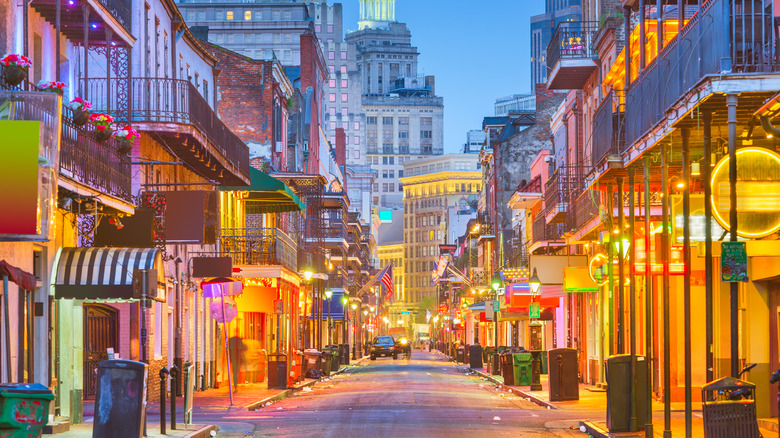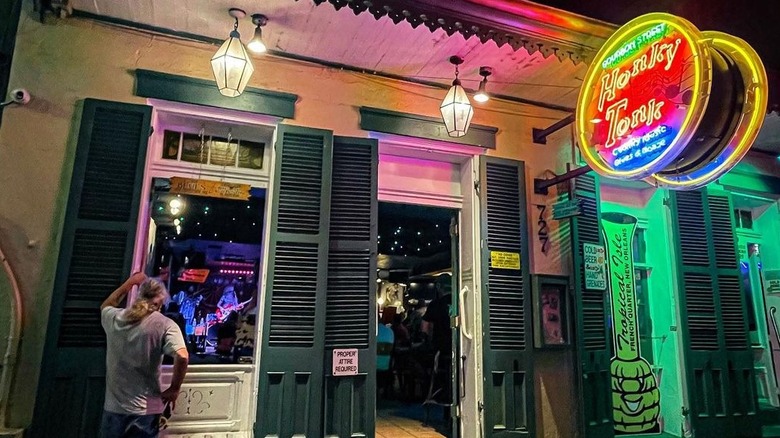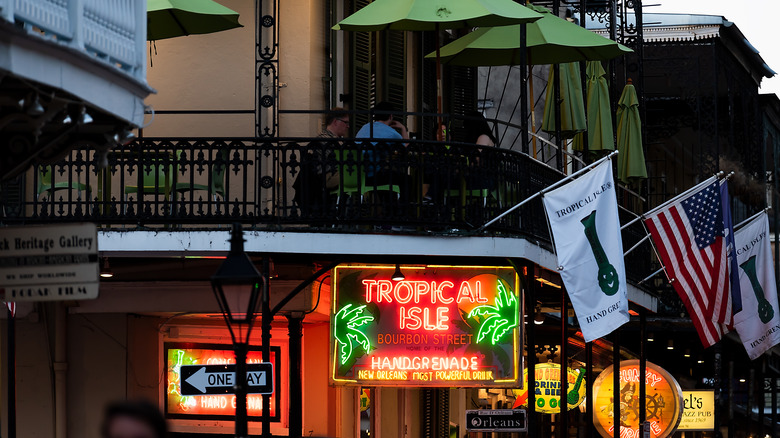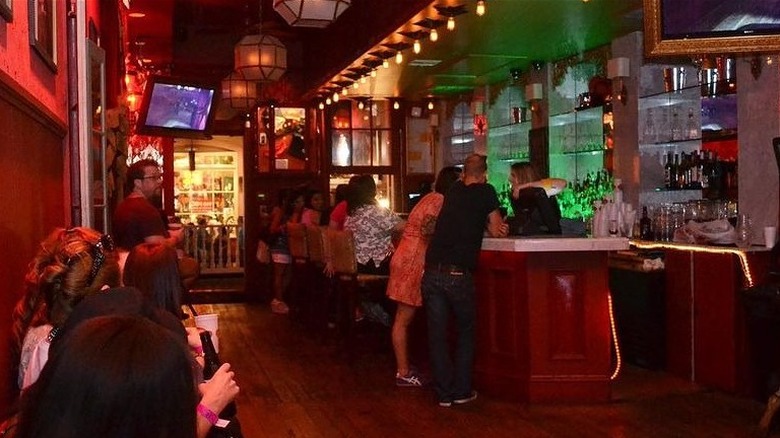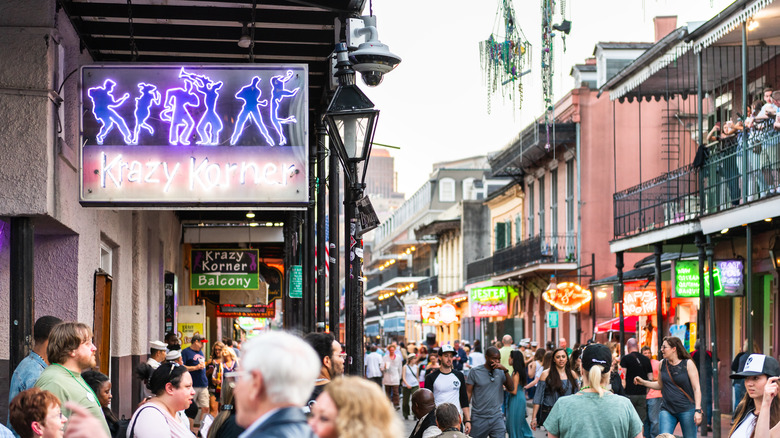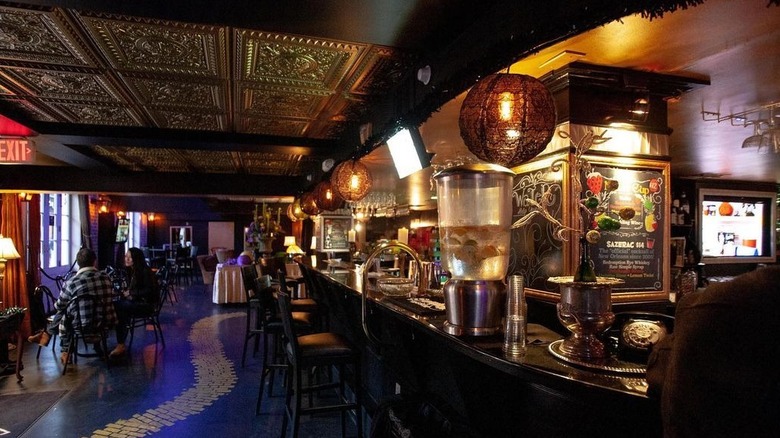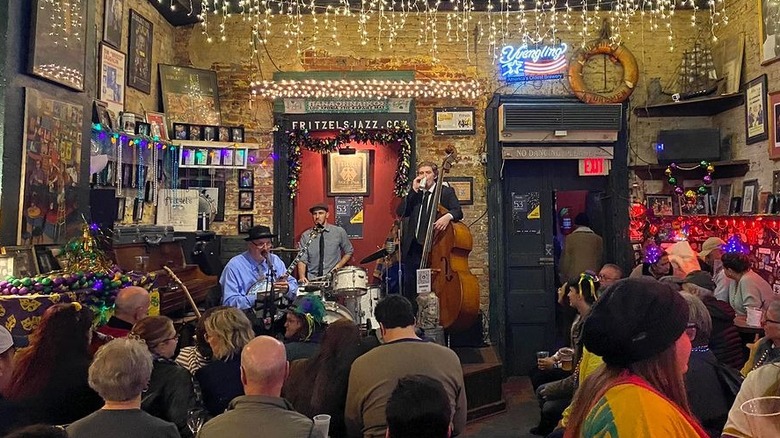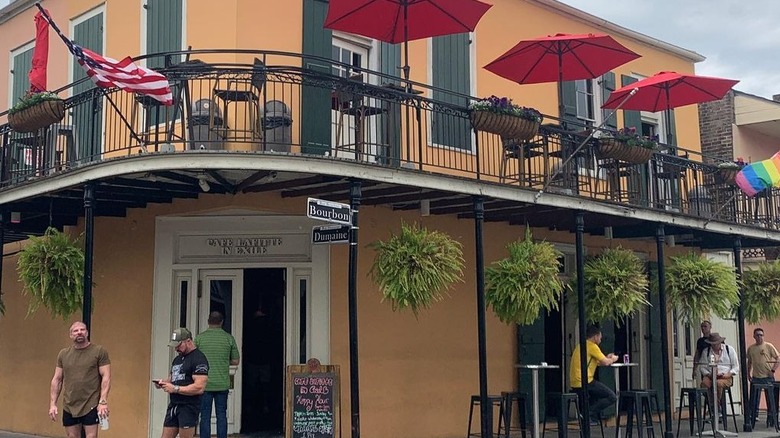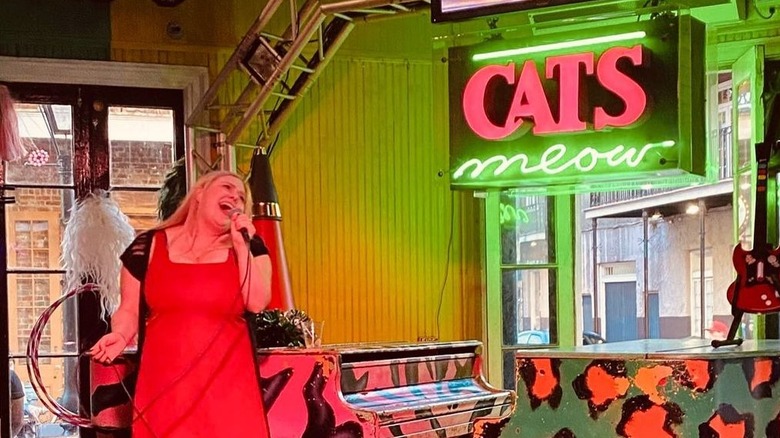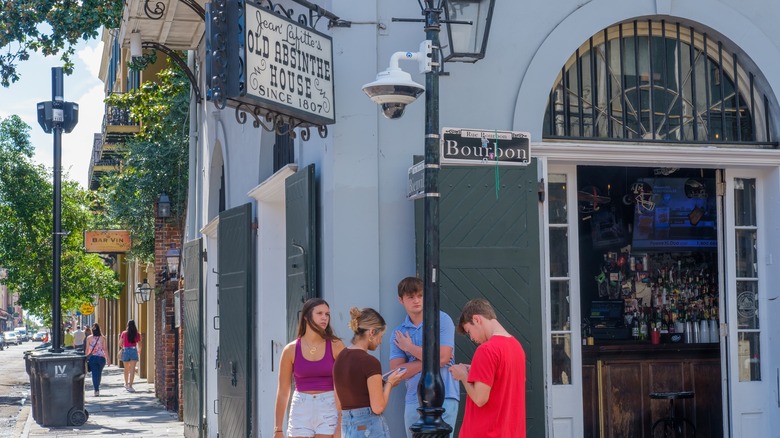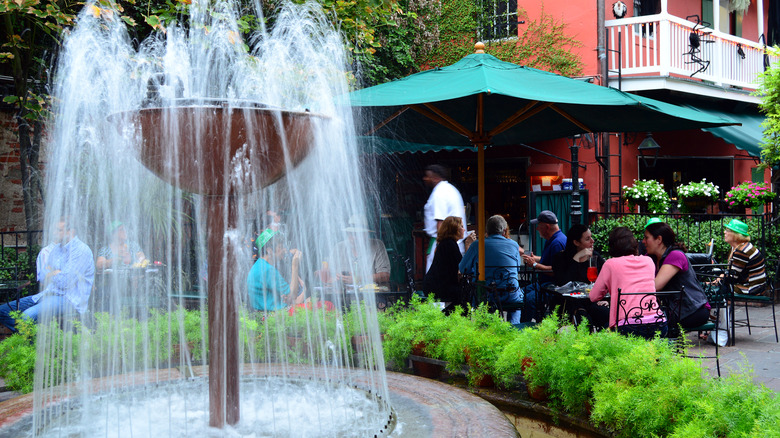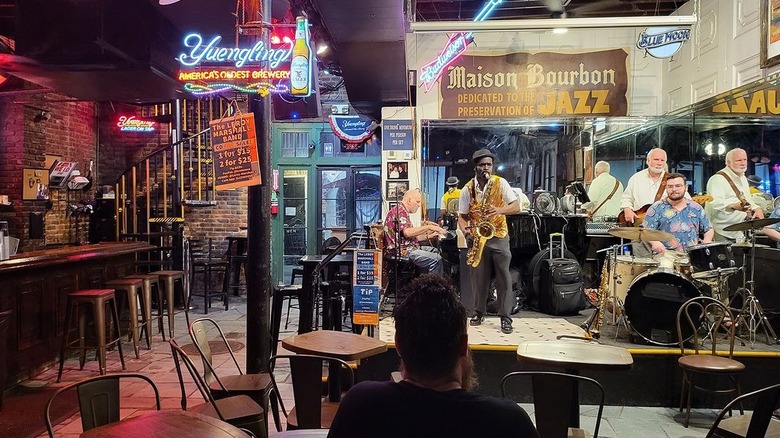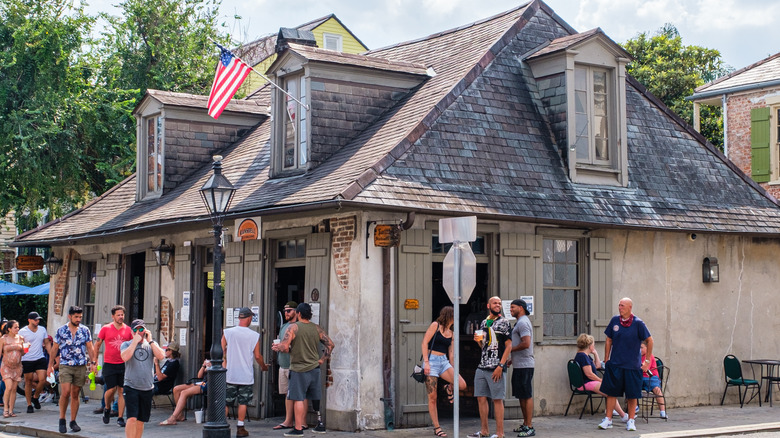12 Best Bars On Bourbon Street, Ranked
When going to experience New Orleans food cuisine and history, Bourbon Street in the city's historic French Quarter district has to be one of your first stops. Every city has an entertainment district, but the blend of cultures and range of experiences on Bourbon makes it unlike any other street in the world. At the Maison Bourbon, world-class jazz musicians play to chin-stroking crowds. Just around the corner, a bar blasts New Orleans' unique style of bounce club music to a room full of twerking bodies. Down the road, a line of people waits to experience melt-in-your-mouth steaks and four-star pampering at Galatoire's Restaurant, one of Emeril Lagasse's favorite restaurants in New Orleans.
Something that bears mentioning: When going to Bourbon Street, it's important to enjoy yourself responsibly. You are in a major city, not Disney World. Plan on going to Bourbon with a group or using the buddy system. If you have to walk down the street alone, blend into the crowd. Above all, respect the strong drinks on Bourbon Street, so your experience ends in cheers, not tears.
If you do it right, Bourbon Street is an amazing bucket list experience that's a bit like the TGI Fridays sampler platter. You can try a bit of everything NOLA and see what you like. Plan on checking out the street's many bars, then exploring the rest of the city based on your favorite music and vibes.
12. Bourbon Street Honky Tonk
For many years, Bourbon Street icon "Big Al" Carson was synonymous with the Funky Pirate bar and its blues-on-the-beach vibe. Not long after Carson passed in 2020, the Funky Pirate was redeveloped into a completely different concept: Bourbon Street Honky Tonk. The country-and-blues theme is more in line with what you'd find on Broad Street in Nashville and a departure from the rest of Bourbon Street, which mostly features rock, blues, jazz, and club music.
You might associate the term "honky-tonk" with country music and the culture of rural white folks. But, honky-tonks have their roots in Black, rural "juke joints" that emerged in the Deep South after emancipation. Because of Jim Crow laws, Black people weren't allowed in whites-only establishments. Juke joints were places where formerly enslaved people and sharecroppers could go for music, dancing, drinking, and gambling. The music at juke joints was heavily inspired by ragtime but more focused on rhythm than melody. As juke joints became more-integrated honky-tonks, the music cultivated there went on to become blues, country, rock, and jazz music.
Despite the deep roots, don't expect a history lesson when you go to Bourbon Street Honky Tonk. Party vibes are a top priority, and you're likelier to hear jukebox jams than old-timey juke joint music.
11. Tropical Isle (Bayou Club)
Featuring a signature beach party vibe that owes a lot to Jimmy Buffet, Tropical Isle is a chain of Bourbon Street bars established by iconic local entrepreneur Earl Bernhardt. After running bars on Bourbon Street for nearly four decades, Bernhardt passed away in December 2019, leaving behind a blurry but impressive legacy. While all of the Tropical Isle bars are worth checking out, the Bayou Club is our pick because it puts many essential NOLA party vibes into a small, intimate package. To wit, the bar regularly hosts live Zydeco music, and the bands will often pass out one or two musical washboards that you can play along with the band. Fun!
With all due respect to the bands, they aren't the biggest draw to the Bayou Club. All of the Tropical Isle bars are known for serving a potent cocktail made with grain alcohol called the Hand Grenade, which comes in a distinctive elongated plastic cup. Drinking a Hand Grenade is a rite of passage when you come to Bourbon Street, and it's also a drink you avoid every time you return. A word of warning: Walking around with the bright green Hand Grenade cup is the sure sign you're a Bourbon Street noob; and a promising target for the street's many panhandlers.
10. Saints and Sinners
When actor Channing Tatum and a longtime friend were looking to open a bar on Bourbon Street, they took inspiration from Storyville, New Orleans' old red-light district that lasted from 1897 to 1917. Located just to the west of Bourbon Street and the historic French Quarter, Storyville was known for attracting musicians, ladies of the night, and men with loose morals. According to legend, the old folk song "House of the Rising Sun" was inspired by an establishment in Storyville.
Saints and Sinners takes the Storyville theme and runs with it. The modern bar-restaurant has a bordello motif that plays up its co-owner's Magic Mike reputation. House cocktails include names like Sex on the Balcony and Burlesque Stress. The bar also hosts crawfish boils regularly happening out front, the perfect lure for hungry tourists looking to get some authentic grub. So yeah, there's a bit of stardust sprinkled all over this Bourbon Street bar, but the overall vibe is a bit theme parkish. If you're with a bachelorette party, this place is a must-stop. If you're looking for an authentic experience, you're better off going elsewhere.
9. Krazy Korner
If you're going to New Orleans, you're probably going for three things: food, live music, and partying. At the corner of Bourbon Street and St. Peter, Krazy Korner is a reliable stop for the latter two. According to the official website, which looks like it's straight out of the Geocities internet era, this corner used to be known in the 1950s and 60s for rhythm-n-blues. Many of the genre's most famous recording artists would visit when they played in New Orleans.
Today, Krazy Korner carries on that tradition by being a live music destination. There's usually a Zydeco band playing in the afternoons, which is convenient if you're looking to get the party started early. Bands play late into the night, cranking out cover songs that would slot into just about any wedding reception playlist. The drinks are strong, are your urge to dance will likely find a safe place to grow at Krazy Korner.
This bar also has a second-floor balcony, which is kind of a big deal on Bourbon Street. In addition to being the perfect Instagram setting, the Krazy Korner balcony is perfect for epic people-watching on Rue Bourbon.
8. Bourbon 'O' Bar
When you go to New Orleans, do you want to stay at a hotel that's right in the belly of the beast? Those who don't mind sleeping (or, let's face it, passing out) just a few yards from epic debauchery should consider the Bourbon Orleans hotel, located at 730 Bourbon St. If you prefer accommodations elsewhere, you can still visit the hotel's Bourbon 'O' Bar, which located on the first floor and facing Bourbon Street.
Specializing in craft cocktails and serving upscale food, the Bourbon 'O' Bar is a welcome respite from down-and-dirty Bourbon Street. Its elegant décor makes you forget about the mysterious street fluids and rank orders flowing right down the road. This bar is also the ideal place to score some iconic New Orleans cocktails, including the Sazerac, Vieux Carré, Grasshopper, and Hurricane — all of which were invented at bars nearby.
The Bourbon 'O' Bar is great, but it's a themed hotel bar that could be anywhere in the world: It's not necessarily part of the fabric of New Orleans. Also, there are much better craft cocktail bars in the city. However, the Bourbon 'O' Bar is a convenient place to wash the taste of a Hand Grenade from your mouth and catch your breath while you scratch that craft cocktail itch.
7. Fritzel's European Jazz Pub
"Intimacy" isn't a word you typically associate with Bourbon Street, but it can be found if you know where to look. Fritzel's European Jazz Pub is one place you can go to get away from the flying beads, thumping club music, and sign-twirling hawkers. Plus, it's one of the few locations on Bourbon Street that harken back to days before electronic music ruled the streets.
Located in a building that dates back to 1831 and has been open since 1969, Fritzel's is dedicated to providing a traditional jazz experience. Lived-in, dark-stained woodwork gives the pub a distinctly Teutonic feel. There's also live jazz 365 days out of the year, played by the resident traditional jazz band.
The bar menu at Fritzel's is focused primarily on cocktails. You can order New Orleans staples or classic beverages. There's even an entire section of the cocktail menu dedicated to drinks made with Jägermeister. The bar also serves a number of domestic and craft beers, including beers from local breweries. Taken together, it's the perfect place to begin or wrap up your Bourbon Street bar crawl.
6. Café Lafitte in Exile
When walking down Bourbon Street, the further you get away from Canal Street, the quieter it gets, relatively speaking. This part of Bourbon is also known for its many gay bars, including a stretch of St. Ann Street that bisects Bourbon called the Lavender Line.
One block over from St. Ann and Bourbon is the oldest continuously operating gay bar in the United States, Café Lafitte in Exile. Since 1933, around the end of Prohibition, the bar has been welcoming to LGBTQ+ people, and over the years, it became an essential stop for gay men coming into New Orleans. According to the official website, Tennessee Williams and Truman Capote were frequent customers.
With changing attitudes, gay bars have begun welcoming broader parts of the communities that they serve. With classic New Orleanian hospitality, Café Lafitte in Exile still welcomes all comers, and it's worth visiting as a part of American history. The bar also has an upstairs balcony perfect for watching whatever's happening on the street below. Unlike our local Walgreens, it's also open 24-7.
5. World Famous Cat's Meow
With its two-floor layout and Bourbon Street audience, the World Famous Cat's Meow is a karaoke bar that stacks the deck in favor of epic performances. First of all, by the time to stumble into the Cat's Meow, you've probably "worked up enough nerve" to get on stage. Your prospective karaoke audience is, likewise, in a good mood. But the best part about the Cat's Meow? A live stream that can send your rendition of White Wedding around the globe. Simply text all of your friends back home before getting on stage and let them watch you embarrass yourself while three sheets to the wind, probably not for the first time.
If you're still feeling apprehensive about singing karaoke, you should know that you don't have to be a good singer. However, there are a few rules you should follow. First, don't sing a ballad unless you know for sure that you will blow the roof off the joint. Second, don't rap: It's harder than it looks, and the lyrics to some rap songs can be problematic. Third, make sure you know at least 90% of the words, not just the chorus. Fourth, if you're going to suck, go down in a blaze of glory: singing at the top of your lungs, walking the stage, and looking your audience right in the eyes.
4. Olde Absinthe House
The Old Absinthe House is one of the oldest bars in New Orleans and a great place to grab a drink in historic surroundings. But your experience is made even better when you know the building's history.
After the building was constructed in 1806, it served as a store for various goods like tobacco and Spanish liquor. In 1815, it became a saloon, and that same year, according to legend, then-general Andrew Jackson met with the famous smuggler Jean Lafitte in the building to plan ahead for the Battle of New Orleans.
The bar was eventually renamed the Absinthe Room after one of the bartenders created a popular absinthe cocktail, first called the Green Monster and then the Absinthe Frappe. The bar was forced to officially close during Prohibition, but it continued as a speakeasy. At some point, the bar was moved to an address down the street, but it eventually moved back to its current location in 2004.
Today, the bar serves a number of cocktails featuring its namesake, including the Absinthe Frappe, Sazerac, and Mother's Milk. There are also several different top-shelf absinthes available that can be ordered neat or on the rocks.
3. Pat O'Brien's Courtyard Restaurant
In the early 20th century, gin and whiskey were the spirits of choice and therefore came at a premium. Rum, on the other hand, was a drink for dirty sailors that went from port to port and, therefore, was very affordable. Because of this, a lot of cocktails developed in the early to mid-20th century featured rum. It's the reason there aren't many tiki cocktails that don't use rum.
Although it's not considered part of the tiki canon, the Hurricane cocktail is a 20th-century rum-based drink that was developed at Pat O'Brien's by then-general manager George Oechsner, Jr., and his team of bartenders. The "a-ha" moment happened when they realized passionfruit juice tastes great with a combination of light and dark rums. Today, the drink is synonymous with New Orleans.
To the pedants out there ready to fire off in the comments: Yes, Pat O'Brien's technically has an address on St. Peter Street, while Pat O'Brien's Courtyard Restaurant has a Bourbon Street address. Practically speaking, the bar is directly accessible from Bourbon Street. So there.
2. Maison Bourbon
Jazz is a big reason Bourbon Street became what it is today, but sadly, it's hard to find live jazz on the street these days. You can see world-class jazz in New Orleans, but the best place to find it is over on Frenchmen Street, which is in the neighborhood just adjacent to the French Quarter.
On Bourbon Street, the most high-profile bar for hearing traditional live jazz is the Maison Bourbon, located at one of the street's busiest intersections. One look at the weathered facade of Maison Bourbon, and you know they do it the old-school way. Expect to hear classic Dixieland jazz and sip on classic beverages. In addition to pretty standard beer and wine options, Maison Bourbon also serves up classic cocktails, including New Orleans classics like the Sazerac and Hurricane. The crowd is always diverse and tends to skew a bit older.
There's one aspect of this bar that can be a bit misleading. Although a sign out from of the Maison Bourbon says it's dedicated to the "preservation of jazz," this bar isn't to be confused with the legendary and nearby Preservation Hall, home of the famous Preservation Hall Jazz Band.
1. Jean Lafitte's Blacksmith Shop Bar
Recognized as the oldest bar in the United States, Jean Lafitte's Blacksmith Shop Bar is a must-stop for during any trip to New Orleans, whether it's your first time or your 100th. Supposedly, the building was built between 1722 and 1723. Functioning as a blacksmith shop by day, hence the name, the building was a base of smuggling activity by night for Jean Lafitte and his brother Pierre.
That's according to legend. Per research by the Times-Picayune (via NOLA.com), the building was more likely built in 1772, and there's no evidence to support the claim that Jean Lafitte was ever associated with it. When you consider the associations with alcohol and smugglers, possible fabrications in the legend should come as no surprise.
Even though there isn't much evidence to back up the legend, Jean Lafitte's still provides an experience that's uniquely New Orleans. The bar is mostly lit by candles, and talented local musicians regularly lead sing-alongs at the piano bar in the back.
